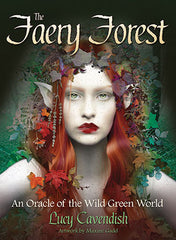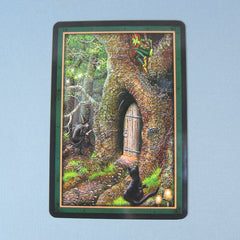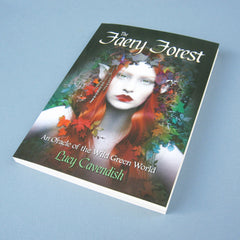
The Faery Forest: An Oracle of the Wild Green World is the newest Faery-themed oracle deck. Released in May 2016, it is the first deck to collect the work of veteran fantasy artist Maxine Gadd. Before adding the title to our store's shelves, we opened one up to have a look.
The Cards
Right away, I was impressed by the quality of the cards and packaging. Publisher Blue Angel is known for doing right by its artists, and this deck is no exception. The printing is vibrant and crisp. (Printing dark colors on cardstock is tricky, but these seem able to resist creasing and scuffing.) The cards are both longer and wider than standard Tarot cards, generously displaying the detailed artwork. The stock is glossy but not glaring. The deck is easy to shuffle by mixing—refreshing because new decks can have issues with stickiness or static cling. The back of the deck features a non-reversible (and hastily composited, sadly) image of a tree house surrounded by denizens of the Faery woods.
Flipping through the deck, you meet the 45 characters and concepts that make up the Green World of the oracle. Faeries, Elves, and green witches populate the Faery Forest. Many of the card names are drawn from European fairy folklore (“The Wild Hunt,” “The Green Man,” “Unseelie Queen”). There are nods to the Norse pantheon (“Freyr,” “Ragnorak”) and rural folk magick (“Hedgewitch,” “Cunningwoman”). There are light Fae and dark Fae, and more than a few that you just can’t be sure about.
Let’s talk about the artwork: Painter and illustrator Maxine Gadd first published an anthology of her Faery paintings in 2005 (re-released in 2010). She followed up the book’s success with appearances at Faeryworlds in 2008 and Glastonbury Faery Fest in 2013. Faery fans enjoy her richly ornamented, ethereal portraits of fantastical beings. In some ways, the oracle functions as a career-spanning retrospective of Maxine Gadd’s work so far.
Gadd credits Brian Froud as one of her early examples, and the influence is evident in the color palettes and leafy costuming of some of her creations. Still, her Faery beings are more blandly pretty than Froudian Fae. A few cards approach the “fashion model with wings” flavor of fairy art. There’s not much here that could be called sinister or grotesque—though she does venture into darker territory than artists like Amy Brown and Jessica Galbreth.
Although the artwork in Faery Forest is vibrant and evocative, it’s not particularly consistent. These 45 images were done in different media at different stages in the artist’s career, and it shows. They range from rather cursory early paintings to highly detailed digital collages. This isn’t a quibble so much as an observation—anyone who likes fantasy art will find something to enjoy in this deck. Some truly stunning images are contained within the Faery Forest collection. It brings to light artwork that is otherwise out-of-print and not commercially available.
The Book
The cards are accompanied by a 138-page, perfect-bound book. Your guide to the Faery Forest is Lucy Cavendish, whose previous oracle deck collaborations include the Wild Wisdom of Faery and Oracle of the Dragonfae. She’s determined to make the oracle accessible to casual seekers and seasoned readers alike.
The book begins with a personal note from Cavendish about the inspiration behind the deck–her travels to sacred sites and encounters with the Fae. She sees them as ancient allies of humanity, who are also unpredictable and wild. They are reserved with their counsel, but are responsive to the open-hearted seeker. She perceives that the Fae are returning to a place of influence in earthly magicks–a statement that will likely ring true with many Witches practicing today.
The next section of the book addresses some concerns common to newbie readers. (Do I need to have certain beliefs to use an oracle deck? Is it okay to let other people handle the cards?) She explains how to do a “daily draw” for personal insight and growth. There is a brief discussion of cultivating psychic receptivity, and some helpful advice for hearing difficult messages and keeping the reading on track. Two of the spreads—Past, Present, Future and Celtic Cross—will already be familiar to card readers. Two more—a five-card Lunar Cycles spread and a ten-card Tree spread—are tailored specifically to the Faery Forest oracle. A black-and-white image and detailed explanation for each card follows.
Overall, the guidebook is thorough and inviting. There’s loads of information here that will help readers to get the most out of this deck. The illustrations and numbering of the cards make flipping to the right section of the book a breeze.
Overall
It’s time for this disclosure: As an old-school Tarot reader, I’m no big fan of oracle decks. While they’re wonderful for solitary reflection, most are just too lacking in depth and breadth to be useful for divination. And their books are full of wishy-washy self-help fluff. Don’t believe me? Grab any oracle deck, and count how many cards can be summed up by the statement: “Change is necessary, but change is hard.” That’s good advice in almost every situation, but it’s not the specific guidance that a reader is often looking for.
Faery Forest, too, leans toward the lighter side, emphasizing pictures that please the eyes and words that soothe the spirit. Whether that’s a bad thing depends on your personal taste and reading style. Despite some misgivings, I found myself elf-struck by this standout oracle.
In the Faery Forest book, Cavendish asserts (rather absurdly) that Faery beings will shrink from “ready judgment” of the merits of this oracle deck. If that’s the case, then may the Faeries forgive me. While the Faery Forest oracle doesn’t transcend the weaknesses of its genre, it’s a worthy addition to any Faery bookshelf or altar.
Enjoy this review? Read more articles here, or buy the deck here.
Images are from The Faery Forest: An Oracle of the Wild Green World (2016), published by Blue Angel and distributed by U.S. Games Systems, Inc.



